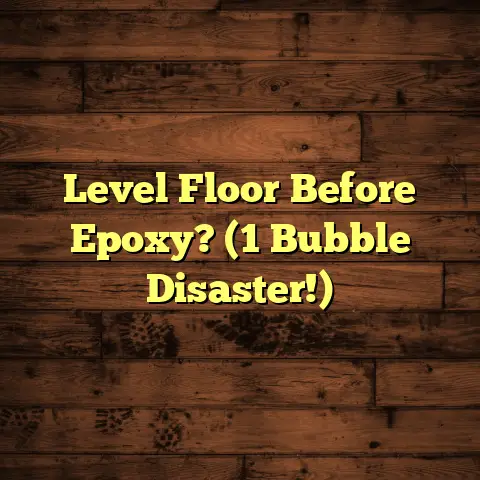Slippery Wood Floors? (3 Fixes You Need Now!)
Ever walk across your beautiful wood floors and feel like you’re ice skating? I’ve seen it happen countless times.
Picture this: Your hands are full of groceries, you’re rushing inside, and whoosh – your feet go out from under you. Heart pounding, groceries scattered, and a bruised ego. Sound familiar?
It’s not just embarrassing, it’s downright dangerous! Slippery wood floors are a common problem, and trust me, I’ve seen the consequences firsthand.
The good news? You don’t have to live in fear of a wipeout. I’m going to walk you through three effective fixes to reclaim your floors and your peace of mind.
Section 1: Understanding the Problem
1.1 Definition and Causes of Slippery Wood Floors
So, what exactly makes wood floors slippery? It’s not always obvious, but it’s usually a combination of factors. I’ve seen it all in my years as a flooring contractor.
-
Finish Type: Some finishes, like high-gloss polyurethanes, are inherently slicker than others. Think of it like comparing an ice rink to a basketball court.
-
Wear and Tear: Over time, the protective layer of your finish wears down, leaving the bare wood exposed. This worn surface can become surprisingly slippery.
-
Humidity: Fluctuations in humidity can cause wood to expand and contract, affecting the surface texture and making it more prone to slipperiness.
-
Cleaning Products: This is a big one! Using the wrong cleaner can leave a residue that builds up over time, creating a slick film on your floors. I can not stress enough on this point.
-
Dust and Debris: Even tiny particles of dust, dirt, and pet dander can act like ball bearings under your feet.
According to the National Safety Council, falls are a leading cause of injury in the home. While they don’t specify wood floors as the sole culprit, it’s safe to say that slippery surfaces contribute significantly to these incidents.
1.2 Consequences of Slippery Floors
Let’s be real, a fall can be more than just a minor inconvenience. I’ve seen falls result in:
-
Broken bones: Wrists, hips, ankles – you name it.
-
Sprains and strains: These can sideline you for weeks.
-
Head injuries: Concussions are no joke.
-
Loss of confidence: Especially for elderly folks, a fall can lead to a fear of moving around their own home.
And it’s not just humans who are at risk. I’ve seen pets struggle on slippery floors, leading to joint problems and anxiety.
Beyond the physical dangers, there’s the constant worry. I can only imagine the stress you feel when you are always afraid of falling.
It’s simply no way to live. That’s why tackling this problem is so important.
Section 2: Fix #1 – Change Your Cleaning Routine
2.1 Identify Common Cleaning Mistakes
Okay, let’s get down to brass tacks. Are you accidentally making your floors more slippery with your cleaning routine? It’s more common than you think.
-
Too Much Water: Wood and water are not friends. Excess water can seep into the wood, causing it to warp and leaving behind a slippery residue.
-
Wrong Cleaning Products: This is a huge one! Many all-purpose cleaners contain harsh chemicals that can strip the finish off your floors, leaving them vulnerable and slick.
-
Using a Dirty Mop: A dirty mop just spreads grime around, creating a build-up of slippery residue.
-
Not Rinsing Properly: Even if you’re using the right cleaner, failing to rinse thoroughly can leave behind a sticky film.
I always advise my clients to avoid anything with harsh chemicals, ammonia, or abrasive ingredients.
2.2 Recommended Cleaning Techniques
Here’s my step-by-step guide to cleaning your wood floors the right way:
-
Dust or Vacuum: Start by removing loose dirt and debris. A microfiber duster or a vacuum with a soft brush attachment works best.
-
Prepare Your Cleaning Solution: Mix a small amount of wood floor cleaner with water according to the manufacturer’s instructions. Or, you can use a solution of 1/4 cup of white vinegar per gallon of water.
-
Damp Mop: Dip a microfiber mop into the cleaning solution, wringing it out thoroughly so it’s just damp, not soaking wet.
-
Mop in the Direction of the Wood Grain: This helps to avoid streaks and ensures even cleaning.
-
Rinse (Optional): If you’re using a commercial cleaner, you may want to rinse with clean water. Again, make sure your mop is only damp.
-
Dry Thoroughly: Use a clean, dry microfiber cloth to buff the floors dry. This will help to prevent water spots and streaks.
Pro Tip: I always recommend using two buckets – one for the cleaning solution and one for rinsing your mop. This keeps the cleaning solution cleaner and more effective.
2.3 Frequency of Cleaning
How often should you clean your wood floors? It depends on your lifestyle and the amount of traffic they receive.
-
High-Traffic Areas: Entryways, kitchens, and hallways may need to be cleaned once or twice a week.
-
Low-Traffic Areas: Bedrooms and living rooms may only need to be cleaned every other week.
General Rule of Thumb: Clean your floors whenever they look dirty or feel sticky. Don’t wait until they’re visibly grimy.
Regular maintenance is key to preventing build-up and keeping your floors safe and beautiful.
Section 3: Fix #2 – Apply Anti-Slip Treatments
3.1 Overview of Anti-Slip Treatments
If changing your cleaning routine isn’t enough, you might consider applying an anti-slip treatment to your wood floors. There are several options available, and I’ve used many of them over the years.
-
Anti-Slip Sprays: These are easy to apply and provide instant traction. However, they tend to wear off quickly and may need to be reapplied frequently.
-
Anti-Slip Coatings: These are more durable than sprays and can last for several months or even years. They typically require more preparation and a longer drying time.
-
Anti-Slip Additives: These are mixed with your existing floor finish to create a non-slip surface. They’re a good option if you’re planning to refinish your floors anyway.
Important Note: Always test any anti-slip treatment in an inconspicuous area before applying it to the entire floor. This will help you to ensure that it doesn’t damage or discolor the finish.
3.2 How to Choose the Right Product
With so many anti-slip treatments on the market, how do you choose the right one for your wood floors? Here are a few factors to consider:
-
Type of Wood Floor: Some treatments are better suited for certain types of wood. For example, oil-based treatments may not be compatible with water-based finishes.
-
Existing Finish: The type of finish on your floors will also affect your choice of anti-slip treatment. Make sure to choose a product that is compatible with your existing finish.
-
Durability: How long do you want the treatment to last? Sprays are the least durable, while coatings and additives tend to be more long-lasting.
-
Ease of Application: Are you comfortable applying the treatment yourself, or would you prefer to hire a professional? Sprays are the easiest to apply, while coatings and additives may require more skill and experience.
-
Safety: Make sure to choose a product that is safe for your family and pets. Look for treatments that are non-toxic and low-VOC.
I’ve found that water-based polyurethane anti-slip coatings tend to be a good all-around choice for most wood floors. They’re durable, easy to apply, and relatively safe.
3.3 Application Process
Once you’ve chosen the right anti-slip treatment, it’s time to apply it. Here’s a general overview of the application process:
-
Prepare the Floor: Clean the floor thoroughly to remove any dirt, dust, or debris. You may also need to sand the floor lightly to create a better surface for the treatment to adhere to.
-
Apply the Treatment: Follow the manufacturer’s instructions carefully. Apply the treatment evenly, using a brush, roller, or sprayer.
-
Allow to Dry: Let the treatment dry completely before walking on the floor. The drying time will vary depending on the product.
-
Apply Additional Coats (Optional): Some treatments require multiple coats for optimal results.
Safety First: Always wear gloves and a mask when applying anti-slip treatments. Make sure to ventilate the area well to avoid inhaling harmful fumes.
I always recommend hiring a professional to apply anti-slip coatings and additives. They have the experience and equipment to ensure a smooth, even finish.
Section 4: Fix #3 – Install Area Rugs and Mats
4.1 Benefits of Area Rugs and Mats
Okay, let’s talk about a simple yet effective solution: area rugs and mats. I know, it might seem obvious, but it’s often overlooked.
-
Increased Traction: Rugs and mats provide a non-slip surface for your feet, reducing the risk of falls.
-
Protection for Your Floors: Rugs and mats can protect your wood floors from scratches, dents, and other damage.
-
Aesthetic Appeal: Rugs and mats can add warmth, color, and style to your home décor.
-
Noise Reduction: Rugs and mats can absorb sound, making your home quieter and more peaceful.
I’ve seen rugs transform a room, not just in terms of safety but also in terms of aesthetics.
4.2 Choosing the Right Rugs
Not all rugs are created equal. When choosing rugs for your wood floors, consider the following:
-
Non-Slip Backing: Look for rugs with a non-slip backing or use a separate rug pad to prevent them from sliding around.
-
Material: Choose a material that is durable, easy to clean, and comfortable underfoot. Wool, cotton, and synthetic fibers are all good options.
-
Size and Shape: Choose a rug that is the right size and shape for the space. A rug that is too small can look awkward, while a rug that is too large can overwhelm the room.
-
Color and Pattern: Choose a color and pattern that complements your existing décor.
Pro Tip: I always recommend using rug pads under your rugs, even if they have a non-slip backing. Rug pads not only prevent slipping but also protect your floors from scratches and dents.
4.3 Placement and Maintenance
Where should you place rugs and mats for maximum effectiveness? Here are a few suggestions:
-
Entryways: Place a mat at each entryway to catch dirt and debris before it gets tracked onto your floors.
-
High-Traffic Areas: Place rugs in hallways, kitchens, and other high-traffic areas to provide extra traction and protection.
-
Near Appliances: Place mats near sinks, stoves, and other appliances to catch spills and prevent water damage.
-
In Front of Furniture: Place rugs in front of sofas, chairs, and beds to create a soft landing spot.
Maintenance Tips:
-
Vacuum Regularly: Vacuum your rugs regularly to remove dirt, dust, and debris.
-
Spot Clean Spills: Clean up spills immediately to prevent staining.
-
Professional Cleaning: Have your rugs professionally cleaned every year or two to keep them looking their best.
I’ve seen clients neglect their rugs, only to find that they’ve become a breeding ground for dust mites and allergens. Regular cleaning is essential for both safety and hygiene.
Conclusion: Recap and Call to Action
So, there you have it – three effective fixes for slippery wood floors:
-
Change Your Cleaning Routine: Use the right cleaning products and techniques to prevent build-up.
-
Apply Anti-Slip Treatments: Consider using a spray, coating, or additive to increase traction.
-
Install Area Rugs and Mats: Strategically place rugs and mats to provide a non-slip surface.
I know dealing with slippery floors can be frustrating, but don’t let it get you down. By implementing these fixes, you can create a safer, more comfortable home environment for yourself, your family, and your pets.
Don’t wait until someone gets hurt. Take action today to reclaim your floors and your peace of mind!
Which fix are you going to try first? Let me know in the comments below! I’m always happy to answer your questions and offer personalized advice.





